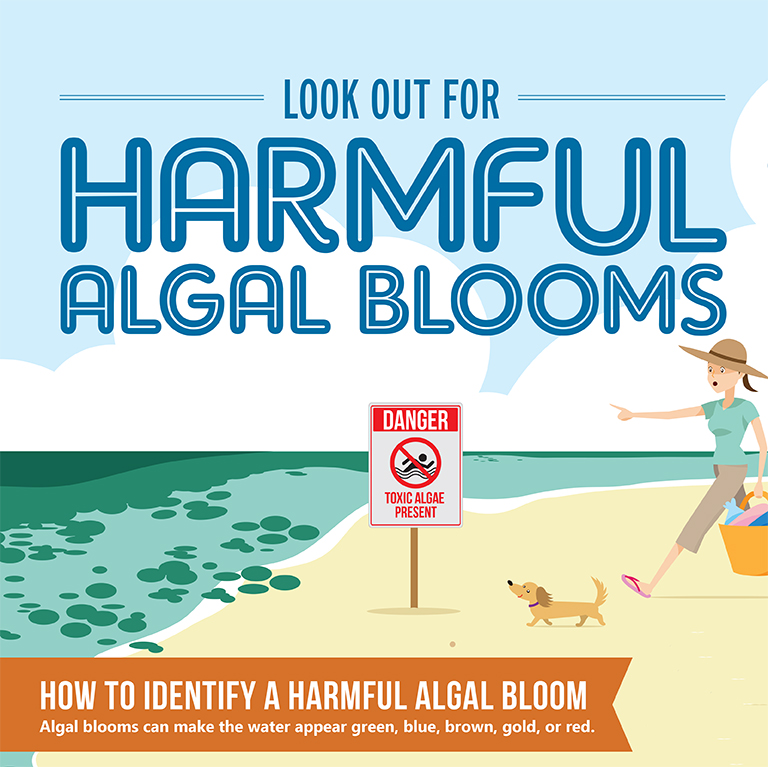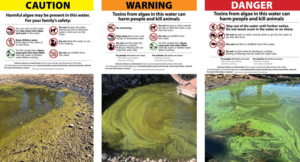
Algae in Lake Tahoe has been a hot topic this summer. While these tiny organisms are a natural part of Tahoe’s aquatic ecosystem, algae can become a harmful algal bloom, or HAB, under the right conditions. No HABs have been detected in Lake Tahoe this summer, but this time of year is when to be on the lookout, when warm, shallow water increases the likelihood for HABs. For everyone who enjoys the region’s lakes, rivers, and creeks, it’s important to know how to spot a HAB, where to report your sightings, and what to do to keep yourselves, your pets, and others safe.
A NATURAL PART OF THE ECOSYSTEM
Lake Tahoe is famous for its blueness. The growth and spread of algae is one reason blue lakes around the world can appear green in the summer. Algae forms the base of many food webs, and most algae in Lake Tahoe, though sometimes unattractive, does not pose a health risk to people or animals. Harmful algal blooms are a different story. HABs can be mistaken for harmless types of algae which naturally occur in Tahoe and can be found clinging to rocks, washing up on beaches, and attached to the bottom of creek and river channels. HABs, however, pose a risk to public health and safety.
The Lahontan Regional Water Quality Control Board (Water Board) places a focus on algae in Tahoe’s waterbodies. They are not alone. The Tahoe Science Advisory Council (Science Council), and notably its member the UC Davis Tahoe Environmental Research Center, studies the presence, abundance, and distribution of Tahoe’s algae over time, and how those characteristics are shifting with climate change. The League to Save Lake Tahoe supports the Science Council’s work. In line with its mission to Keep Tahoe Blue, the League stresses the importance of water quality monitoring and scientific efforts to better understand how algae behaves and impacts the Tahoe region.
WHAT IS A HARMFUL ALGAL BLOOM?
HABs are formed by tiny organisms called cyanobacteria and can make the water a variety of colors such as green, white, red, or brown. HABs may look like thick paint floating on the water or as algal mats in rivers, streams, and along the shallow shorelines of lakes. In lakes, HABs usually appear as a mix of intense shades of green in a paint-like sheen on the water’s surface. In rivers, HABs typically look like algal mats that are attached to the channel bottom. Strong winds or waves can dislodge algal mats and push them onto shorelines. This guide can help you identify a HAB.
Common factors contributing to algal blooms are warmer temperatures, slow or stagnant water, and nutrients in the water that serve as food for algal organisms. Current research suggests that rising temperatures and changing precipitation events associated with climate change may contribute to the increase in HAB events. Here’s why:
- Warmer temperatures can propagate algal blooms because cyanobacteria (the tiny organisms that make up a bloom) are adapted to hot conditions.
- Intervals of drought can contribute to stagnant or slow-moving water, which helps harmful algae grow.
- If extreme rainfall events become more frequent (as they are projected to) stormwater, surface water, and groundwater discharges will deliver more nutrients to water bodies, fueling the growth of HABs.
MONITORING FOR HABs
On the California side of Lake Tahoe, the Water Board tests and monitors water quality, coordinates with land managers, and provides signage to warn the public of risks associated with HABs. The Water Board conducts routine testing at popular and susceptible sites, and they respond rapidly to reports from the public, especially within the Lake Tahoe Basin. We encourage you to report HAB sightings through this website. The information in this article and this webpage can help you identify and report possible HABs.
Lake Tahoe’s waters were monitored multiple times at various beaches this summer as part of routine testing. Tests were conducted before busy holiday weekends (Memorial Day, Fourth of July, and Labor Day) and in response to HAB reports submitted by the public. No toxins have been detected in any samples collected from the California side of Lake Tahoe so far this season, including during the most recent round of testing conducted on August 20 at Kings, El Dorado, Regan, and Kiva beaches. However, visual signs of algae were observed at Kiva Beach in July, prompting the placement of Caution and Check for Algae signs.
The Tahoe Keys lagoons were also monitored at various locations throughout the summer. A sample collected from the lagoon at the corner of Venice Dr. and Alpine Dr. in July showed toxin levels that triggered a Warning advisory, causing Warning signage to be placed in that area. Re-testing occurred in August showing that the HAB in this area of the lagoon has since dissipated to a Caution advisory level. Caution signs were placed throughout the rest of the Tahoe Keys lagoons based on the test results and visual indicators of HABs in other sample locations.
Keep reading to understand the differences between the HAB advisory levels: Caution, Warning, and Danger.
We encourage you to stay vigilant, report HABs when you see them, and follow these healthy water habits.
HAB SIGNS AND WHAT THEY MEAN FOR YOU
The Water Board relies on three tiers of signage to inform the public about HABs. From lowest to highest, they are Caution, Warning, and Danger. These signs, or advisories, recommend what you should and should not do in areas experiencing a HAB. Advisory levels typically apply to specific affected areas and not entire waterbodies.
Land managers can choose to place advisory signs (typically at the Caution level) in an abundance of caution, even when the presence of a HAB has not been confirmed. To keep the public on notice of a potential HAB, land managers may leave advisory signs in place after a previously confirmed HAB has dissipated.
In addition to Caution, Warning, and Danger advisories, there are also Check for Algae and Algal Alert signs, which you can see here.
WHAT YOU CAN DO
First and foremost, stay informed and aware of how to spot a HAB, where to report it, and how to avoid putting yourself, your loved ones, and pets at risk. Use the resources below.
If you think you’ve spotted a HAB, share that information with the Water Board for the California side of the Tahoe Basin, and with the Nevada Division of Environmental Protection for the Nevada side.
– How to identify a HAB
– Report a bloom in California
– Report a bloom in Nevada
– California incident report map
– Nevada HAB dashboard and map
– How to keep you, your family, and pets safe from HABs
– Frequently asked questions
###
MEDIA CONTACT:
Chris Joseph, Communications Director, League to Save Lake Tahoe
cjoseph@keeptahoeblue.org, 530.541.5388 ext.206
The League to Save Lake Tahoe is the donor-funded, science-based organization of environmental experts and Tahoe-lovers behind Keep Tahoe Blue. We have led the protection and regeneration of the Lake since 1957 and remain the central environmental body in the Basin. The Tahoe Basin sits at the nexus of two states, five counties, and dozens of agencies and nonprofits. We are the one organization making sure everyone works together toward the same goal – to Keep Tahoe Blue. Our work is made possible through the generosity of our donors and volunteers. Learn more, donate, and get involved at keeptahoeblue.org.



